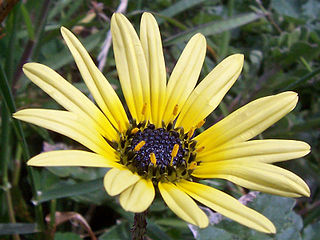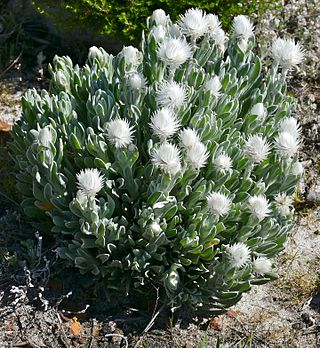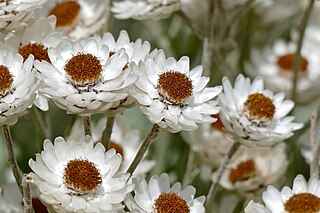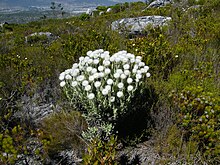
Osteospermum, is a genus of flowering plants belonging to the Calenduleae, one of the smaller tribes of the sunflower/daisy family Asteraceae. They are known as the daisybushes or African daisies. Its species have been given several common names, including African daisy, South African daisy, Cape daisy and blue-eyed daisy.

Lotononis is a genus of flowering plants in the family Fabaceae and the tribe Crotalarieae. The genus includes 99 species of annual and perennial herbs, native to the southeastern Europe and Turkey, eastern Africa, and southern Africa.

Arctotheca is a small genus of flowering plants in the family Asteraceae. They are annuals or perennials native to southern Africa. It is becoming an invasive weed in other parts of the world.

Aspalathus is a genus of flowering plants in the family Fabaceae. The yellow flowers and spiny habit of some species have suggested a resemblance to Ulex europaeus, the thorny "English gorse" Accordingly, "Cape Gorse" has been proposed as a common name although the resemblance is largely superficial; for instance, gorse is thorny, whereas Aspalathus species are variously spiny or unarmed. The genus belongs to the subfamily Faboideae. There are over 270 species, mainly endemic to southwestern fynbos regions in South Africa, with over fifty occurring on the Cape Peninsula alone. The species Aspalathus linearis is commercially important, being farmed as the source of Rooibos tea.

Lessertia is a genus of flowering plants in the legume family, Fabaceae. It contains some 62 species native to eastern and southern Africa. It belongs to subfamily Faboideae.

Oncosiphon is a small genus of flowering plants in the daisy family (Asteraceae). All known species are native to southern Africa.

Xiphotheca is a genus of flowering plants in the legume family, Fabaceae. It includes 10 species of shrubs endemic to the Cape Provinces of South Africa. They grow in fynbos, generally at medium or low elevations, and often species have highly localised ranges. The genus belongs to the subfamily Faboideae. The name of the genus is a compound of Ancient Greek ξίφος (ksíphos), which means "sword", and θήκη (thēkē) which can mean "box" or "sheath"—a reference to the shape of the legume pods. Members of this genus can be distinguished by:
"(1) the presence of bracteoles in most species; (2) the fusion of the bracts with the base of the pedicel; (3) the laterally compressed pods; and (4) the accumulation of anabasine as a major alkaloid."
Edward Stuart Cardinal Dyke was a prominent naturalist, photographer, and botanical explorer in South Africa during the late 19th to early 20th century. He associated with the leading botanical lights of the day, including Rudolf Marloth, to whom he donated many specimens and many of the photographs that appeared in Marloth's monumental work, “The Flora of South Africa”. Some plant species were named after him. As a young man he fought in the Second Boer War. In World War I he was one of the first to die in the campaign in South-West Africa.

Diastella is a genus containing seven species of flowering plants, commonly known as “silkypuffs”, in the protea family. The name comes from the Greek diastellein “to separate”, with reference to the free perianth lobes – the plants are distinguished from the closely related and similar leucospermums by the possession of four free perianth segments. The genus is endemic to the Cape Floristic Region of South Africa where it has a very limited range and is associated with fynbos habitats. The species are all small shrubs. Most species are threatened.

Prismatocarpus is a genus of flowering plants belonging to the family Campanulaceae.

Syncarpha vestita is a species of flowering plant. It belongs to the genus Syncarpha, and family Asteraceae. It is endemic to the Cape Provinces of South Africa.

Syncarpha argyropsis is a species of flowering plant found on the south coast of South Africa. It was first described as Helipterum argyropsis by DC. in 1838, and given the current name by Rune Bertil Nordenstam in 1989. Syncarpha argyropsis belongs to the genus Syncarpha and family Asteraceae.











